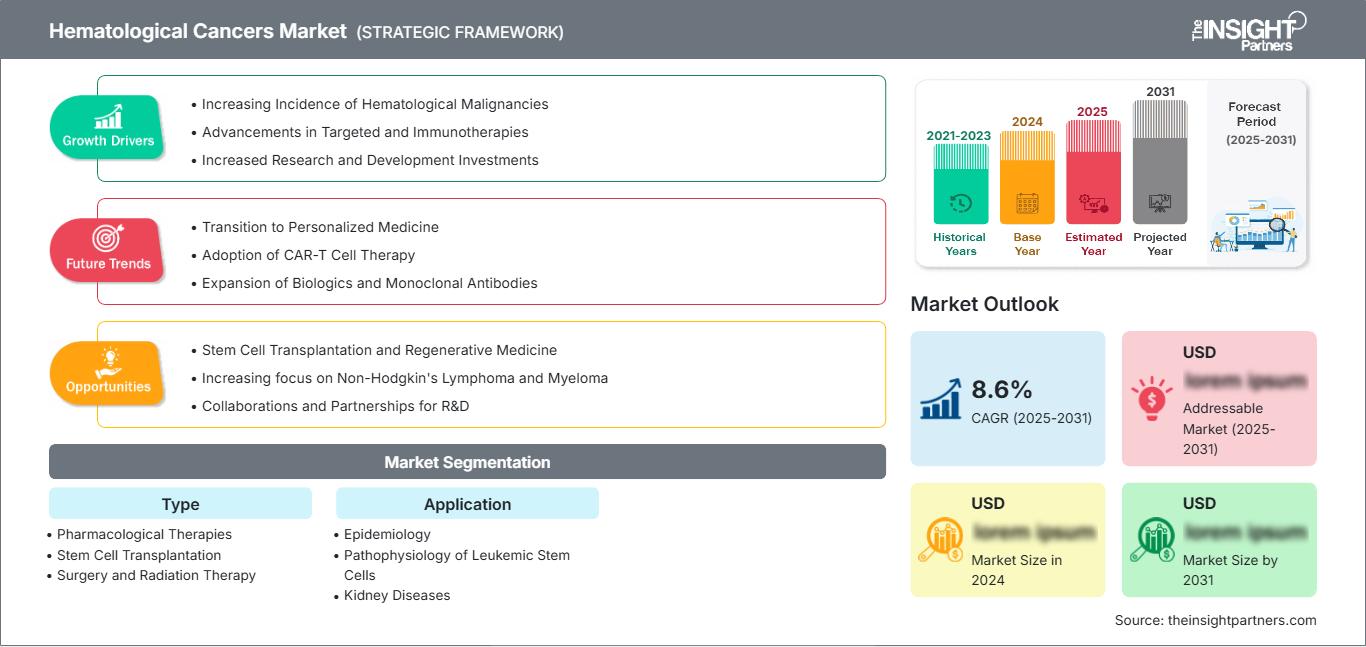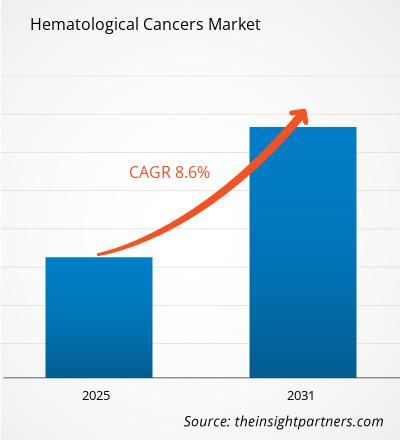Le marché des cancers hématologiques devrait enregistrer un TCAC de 8,6 % entre 2025 et 2031, avec une taille de marché passant de XX millions de dollars américains en 2024 à XX millions de dollars américains d'ici 2031.
Le rapport sur le marché des cancers hématologiques couvre l'analyse par type (thérapies pharmacologiques, transplantation de cellules souches, chirurgie et radiothérapie, traitement de l'anémie, traitement de la thrombose, traitement de la neutopénie, traitement symptomatique) ; application (épidémiologie, physiopathologie des cellules souches leucémiques, maladies rénales, maladies génétiques, autres maladies) ; et géographie (Amérique du Nord, Europe, Asie-Pacifique et Amérique du Sud et centrale). L'analyse mondiale est ensuite ventilée au niveau régional et par principaux pays. Français Le rapport offre la valeur en $ US pour l'analyse et les segments ci-dessus.
Objectif du rapport
Le rapport sur le marché des cancers hématologiques de The Insight Partners vise à décrire le paysage actuel et la croissance future, les principaux facteurs moteurs, les défis et les opportunités. Cela fournira des informations à diverses parties prenantes commerciales, telles que :
- Fournisseurs/fabricants de technologies : pour comprendre la dynamique évolutive du marché et connaître les opportunités de croissance potentielles, leur permettant de prendre des décisions stratégiques éclairées.
- Investisseurs : pour réaliser une analyse complète des tendances concernant le taux de croissance du marché, les projections financières du marché et les opportunités qui existent tout au long de la chaîne de valeur.
- Organismes de réglementation : pour réglementer les politiques et les activités de police sur le marché afin de minimiser les abus, de préserver la confiance des investisseurs et de maintenir l'intégrité et la stabilité du marché.
Type de segmentation du marché des cancers hématologiques
- Thérapies pharmacologiques
- Transplantation de cellules souches
- Chirurgie et radiothérapie
- Traitement de l'anémie
- Traitement de la thrombose
- Traitement de la neutopénie
- Traitement symptomatique
Application
- Épidémiologie
- Physiopathologie des cellules souches leucémiques
- Maladies rénales
- Maladies génétiques
- Autres maladies
Vous bénéficierez d’une personnalisation sur n’importe quel rapport - gratuitement - y compris des parties de ce rapport, ou une analyse au niveau du pays, un pack de données Excel, ainsi que de profiter d’offres exceptionnelles et de réductions pour les start-ups et les universités
Marché des cancers hématologiques: Perspectives stratégiques

- Obtenez les principales tendances clés du marché de ce rapport.Cet échantillon GRATUIT comprendra une analyse de données, allant des tendances du marché aux estimations et prévisions.
Moteurs de croissance du marché des cancers hématologiques
- Incidence croissante des hémopathies malignes : L’incidence mondiale des cancers hématologiques est en constante augmentation, alimentant ainsi la croissance du marché. Le vieillissement de la population, les changements de mode de vie et les influences environnementales sont des facteurs connexes qui présentent une trajectoire ascendante. La leucémie, le lymphome et le myélome sont parmi les cancers hématologiques les plus fréquemment diagnostiqués, et leur prévalence croissante entraîne une augmentation de la demande de thérapies, de diagnostics et d’options de traitement avancés.
- Progrès dans les thérapies ciblées et les immunothérapies : Le développement des thérapies ciblées et des immunothérapies a considérablement modifié le paradigme thérapeutique des cancers hématologiques. Les thérapies ciblées se concentrent sur des cibles moléculaires spécifiques associées aux cellules cancéreuses, tandis que les immunothérapies telles que la thérapie CAR-T (Chimeric Antigen Receptor T-cell) se sont avérées très efficaces dans le traitement de certains cancers du sang. Ces traitements innovants stimulent la croissance du marché des cancers hématologiques en offrant des options thérapeutiques plus efficaces et moins toxiques que la chimiothérapie traditionnelle.
- Augmentation des investissements en recherche et développement : Le marché des cancers hématologiques bénéficie d'un investissement crucial et continu de la part des sociétés pharmaceutiques et biotechnologiques en matière de recherche et développement. En février 2024, AbbVie Inc. a racheté ImmunoGen Inc., notamment sa thérapie phare contre le cancer, ELAHERE. Cette acquisition devrait accélérer la présence commerciale et clinique d'AbbVie dans le domaine des tumeurs solides. Les entreprises se concentrent sur le développement de médicaments, de thérapies et de traitements contre le cancer hématologique. Cela a conduit à de nouveaux efforts de recherche et développement pour découvrir des cibles moléculaires, des approches thérapeutiques efficaces et des avancées vers la médecine personnalisée afin de stimuler la croissance du marché.
Tendances futures du marché des cancers hématologiques
- Transition vers la médecine personnalisée : L'une des tendances les plus marquantes du marché des cancers hématologiques est l'accent accru mis sur la médecine personnalisée ou de précision. Les traitements adaptés au patrimoine génétique d'un individu ainsi qu'aux caractéristiques spécifiques de ses cellules cancéreuses ont gagné en popularité. Les thérapies personnalisées, notamment les traitements ciblés et les immunothérapies, améliorent les résultats pour les patients et réduisent les effets indésirables ; cela offre un moyen plus efficace de traiter les cancers hématologiques.
- Adoption de la thérapie cellulaire CAR-T : La thérapie cellulaire CAR-T révolutionne le traitement de certains cancers hématologiques, comme les lymphomes à cellules B récidivants ou réfractaires et la leucémie. Cette immunothérapie vise à modifier les lymphocytes T du patient pour cibler et tuer les cellules cancéreuses. Le succès des thérapies CAR-T, telles que Kymriah et Yescarta, stimule l'expansion du marché des cancers hématologiques, notamment avec l'élargissement des indications pour d'autres cancers du sang et les améliorations constantes de la technologie.
- Expansion des produits biologiques et des anticorps monoclonaux : L'utilisation de produits biologiques et d'anticorps monoclonaux est en augmentation dans le traitement des cancers hématologiques. Les anticorps monoclonaux, notamment le Rituximab pour le lymphome et le Daratumumab pour le myélome, font désormais partie intégrante des schémas thérapeutiques. Ces produits biologiques peuvent cibler des protéines spécifiques dans les cellules cancéreuses, ce qui peut conduire à de meilleurs résultats et à moins d'effets secondaires. Roche a lancé un nouveau test d'hybridation SITU hautement sensible en juin 2024. Ce test récemment approuvé cliniquement doit aider les pathologistes à différencier une tumeur maligne à cellules B d'une tumeur normale. Ce lancement permet de tester davantage de patients diagnostiqués susceptibles d'être atteints d'un lymphome à cellules B. L'avenir du marché des cancers hématologiques est façonné par le développement continu de nouveaux produits biologiques et d'anticorps monoclonaux.
Opportunités de marché des cancers hématologiques
- Transplantation de cellules souches et médecine régénérative : La transplantation de cellules souches hématopoïétiques, communément appelée greffe de moelle osseuse, est considérée comme une pierre angulaire du traitement de nombreux cancers hématologiques, dont la leucémie et le lymphome. De nouvelles opportunités d'innovation s'ouvrent grâce aux progrès de la technologie des cellules souches, notamment l'amélioration de la prise en charge de la maladie du greffon contre l'hôte et l'amélioration des greffes. On s'attend à ce que les nouvelles thérapies par cellules souches, alliées à la médecine régénérative, produisent de nouvelles options très efficaces qui bénéficieraient aux patients exclus par d'autres formes de traitement.
- Intérêt croissant pour le lymphome non hodgkinien et le myélome : les traitements contre la leucémie ont progressé, tandis que d'autres cancers hématologiques, comme le lymphome non hodgkinien et le myélome, suscitent une attention croissante. L'incidence du lymphome non hodgkinien est en augmentation partout dans le monde, et le myélome ne dispose toujours pas de traitement très efficace pour les stades avancés. De nouveaux médicaments, des médicaments personnalisés et des médicaments biologiques ciblent tous ces cancers et présentent un énorme potentiel de croissance du marché.
- Collaborations et partenariats en R&D : Les entreprises pharmaceutiques stratégiques, les partenariats et les organismes de recherche, en collaboration avec des instituts universitaires, ouvrent d’importantes perspectives pour le développement de nouveaux traitements contre les hémopathies malignes. La recherche partagée conduit à de nouveaux produits thérapeutiques, notamment dans des domaines émergents comme l’édition génomique, l’immunothérapie ou la thérapie ciblée. Ce partenariat permettrait d’accélérer le processus de création d’un nouveau produit médical.
Marché des cancers hématologiques
Les tendances régionales et les facteurs influençant le marché des cancers hématologiques tout au long de la période de prévision ont été analysés en détail par les analystes de The Insight Partners. Cette section aborde également les segments et la répartition géographique du marché des cancers hématologiques en Amérique du Nord, en Europe, en Asie-Pacifique, au Moyen-Orient et en Afrique, ainsi qu'en Amérique du Sud et en Amérique centrale.Portée du rapport sur le marché des cancers hématologiques| Attribut de rapport | Détails |
|---|---|
| Taille du marché en 2024 | US$ XX million |
| Taille du marché par 2031 | US$ XX Million |
| TCAC mondial (2025 - 2031) | 8.6% |
| Données historiques | 2021-2023 |
| Période de prévision | 2025-2031 |
| Segments couverts |
By Type
|
| Régions et pays couverts | Amérique du Nord
|
| Leaders du marché et profils d'entreprises clés |
|
Densité des acteurs du marché des cancers hématologiques : comprendre son impact sur la dynamique des entreprises
Le marché des cancers hématologiques connaît une croissance rapide, portée par une demande croissante des utilisateurs finaux, due à des facteurs tels que l'évolution des préférences des consommateurs, les avancées technologiques et une meilleure connaissance des avantages du produit. Face à cette demande croissante, les entreprises élargissent leur offre, innovent pour répondre aux besoins des consommateurs et capitalisent sur les nouvelles tendances, ce qui alimente la croissance du marché.
- Obtenez le Marché des cancers hématologiques Aperçu des principaux acteurs clés
Principaux arguments de vente
- Couverture exhaustive : Le rapport couvre l’analyse exhaustive des produits, services, types et utilisateurs finaux du marché des cancers hématologiques, offrant un panorama global.
- Analyse d’experts : Le rapport est élaboré à partir de la connaissance approfondie d’experts et d’analystes du secteur.
- Informations actualisées : Le rapport garantit la pertinence commerciale grâce à sa couverture des informations récentes et des tendances des données.
- Options de personnalisation : Ce rapport peut être personnalisé pour répondre aux besoins spécifiques des clients et s’adapter aux stratégies commerciales.
Le rapport de recherche sur le marché des cancers hématologiques peut donc contribuer à la compréhension du marché et des perspectives de croissance. Malgré quelques préoccupations légitimes, les avantages globaux de ce rapport tendent à l’emporter sur les inconvénients.
- Analyse historique (2 ans), année de base, prévision (7 ans) avec TCAC
- Analyse PEST et SWOT
- Taille du marché Valeur / Volume - Mondial, Régional, Pays
- Industrie et paysage concurrentiel
- Ensemble de données Excel
Rapports récents
Témoignages
Raison d'acheter
- Prise de décision éclairée
- Compréhension de la dynamique du marché
- Analyse concurrentielle
- Connaissances clients
- Prévisions de marché
- Atténuation des risques
- Planification stratégique
- Justification des investissements
- Identification des marchés émergents
- Amélioration des stratégies marketing
- Amélioration de l'efficacité opérationnelle
- Alignement sur les tendances réglementaires




















 Obtenez un échantillon gratuit pour - Marché des cancers hématologiques
Obtenez un échantillon gratuit pour - Marché des cancers hématologiques